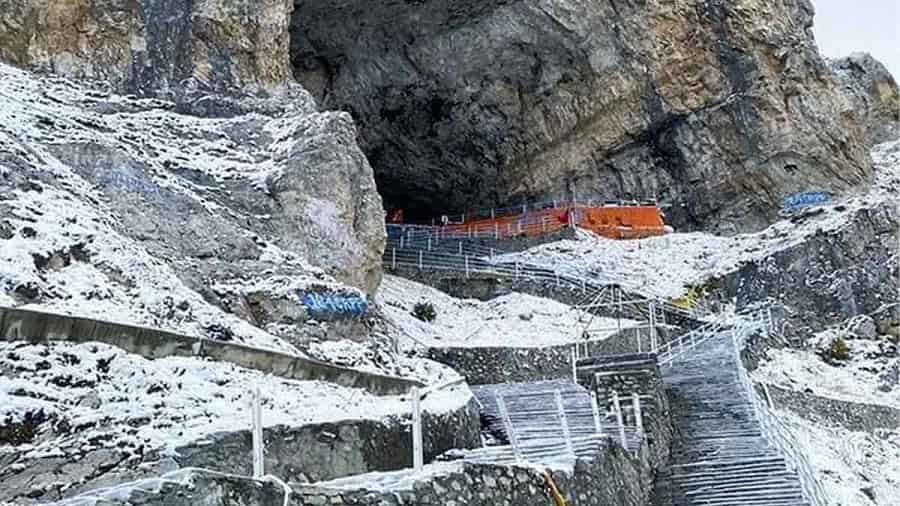Embarking on a spiritual journey that winds through the breathtaking landscapes of the Himalayas, the Amarnath Yatra stands as a testament to the unwavering faith of devotees. This annual pilgrimage holds a profound place in Hindu culture, encompassing a history enriched with legends and a significance that transcends time. This article delves into the captivating history, the mesmerizing story, the deep-rooted significance, and the enduring importance of the Amarnath Yatra.

The Origins and History
Ancient Reverence
The roots of the Amarnath Yatra stretch back into the annals of Hindu mythology. According to the sacred texts, it is believed that Lord Shiva chose the secluded Amarnath Cave to disclose the secret of immortality to his divine consort Parvati. The enigmatic formation within the cave, an ice stalagmite, symbolizes this sacred revelation. As such, the cave has evolved into a site of deep veneration, drawing countless pilgrims seeking blessings and a connection with the divine.
Centuries-Old Tradition
The Amarnath Yatra is not merely a ritual; it’s an age-old tradition that has weathered the test of time. Its origins can be traced to the era of Maharaja Ranjit Singh, who fostered the pilgrimage during his reign. Through the ages, the yatra has grown from a regional event to a national phenomenon, attracting devotees from every corner of India and beyond. This journey, which stretches for around 42 kilometers, is more than a physical endeavor; it’s a spiritual odyssey that binds generations together in their devotion to Lord Shiva.
The Fascinating Story
The Icy Shiva Lingam
Central to the allure of the Amarnath Cave is the formation of an ice stalagmite that closely resembles the revered Shiva Lingam. This natural wonder, considered a divine manifestation, appears as though Lord Shiva himself is present in the cave. What adds to the mystique is the ice Lingam’s cyclical growth and diminution, synchronized with the waxing and waning of the moon. The full moon marks the pinnacle of its size, attracting throngs of pilgrims who believe that a glimpse of the ice Lingam brings them closer to their spiritual aspirations.
The Challenging Terrain
The path to the Amarnath Cave is not for the faint-hearted. Pilgrims undertake an arduous trek through rugged terrain, traversing steep mountains and enduring extreme weather conditions. The journey, which typically takes several days, tests the physical and mental endurance of each devotee. Yet, the trials are embraced willingly, as the difficulties of the journey are seen as a metaphor for life’s challenges, with the ultimate reward being a deepened connection with the divine.
The Profound Significance
Spiritual Purification
The Amarnath Yatra is not just a physical journey; it’s a quest for spiritual purification and enlightenment. Devotees believe that undertaking this pilgrimage absolves them of their sins and helps them attain salvation. The challenging conditions and sacrifices made during the journey are viewed as acts of devotion and penance, leading to a sense of spiritual upliftment.
Cultural and Social Unity
The yatra transcends religious boundaries and unites people from various walks of life. It’s a remarkable spectacle of communal harmony, where individuals come together in their shared devotion. The yatra fosters a sense of unity, highlighting the cultural diversity and secular fabric of India.
The Enduring Importance
Preserving Heritage
The Amarnath Yatra plays a vital role in preserving India’s rich cultural and spiritual heritage. It serves as a living link to ancient traditions and offers a glimpse into the country’s profound spiritual legacy. The pilgrimage acts as a bridge between generations, passing down beliefs and stories from one era to the next.
Boosting Tourism
Apart from its spiritual significance, the Amarnath Yatra also contributes significantly to the region’s economy. The pilgrimage attracts a substantial number of tourists and pilgrims, boosting local businesses and livelihoods. It’s a prime example of how faith and tourism can go hand in hand, benefiting both spiritual seekers and the local community.












 Call
Call WhatsApp
WhatsApp Enquiry
Enquiry